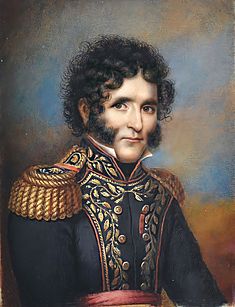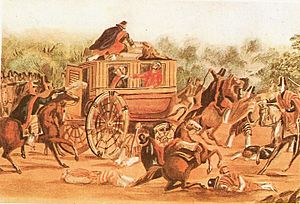Facundo Quiroga facts for kids
Quick facts for kids
Facundo Quiroga
|
|
|---|---|

Portrait by Fernando García del Molino.
|
|
| 3º governor of La Rioja | |
| Personal details | |
| Born | November 27, 1788 La Rioja, Viceroyalty of the Río de la Plata (now Argentina) |
| Died | February 16, 1835 (aged 46) Barranca Yaco, Córdoba, Argentina |
| Resting place | La Recoleta Cemetery |
| Political party | Federal |
| Nickname | El Tigre de los Llanos |
| Military service | |
| Allegiance | Argentine Confederation |
| Battles/wars | Desert Campaign (1833–34) |
Juan Facundo Quiroga (born November 27, 1788 – died February 16, 1835) was an important Argentine leader. He was known as a caudillo, which means a strong military leader. Quiroga strongly believed in federalism, a system where different regions or states have power, not just a central government. This was at a time when Argentina was still forming as a country.
Contents
Early Life and Nickname
Facundo Quiroga was born in San Antonio, in the La Rioja region. His family was traditional but not very rich. They raised cattle. When he was young, he was sent to San Juan for school.
However, Facundo was a bit of a troublemaker. He ran away from school. It is said that during his travels in the desert, he met and killed a cougar. This earned him the famous nickname El Tigre de los Llanos, meaning "the Tiger of the Plains." The Llanos refers to the flat lands where he was born.
Joining the Army
After the May Revolution in 1810, Argentina declared its self-rule. Quiroga wanted to join the army that was fighting for independence. He went to San Luis to join the Granaderos a Caballo Regiment. This famous group was led by General José de San Martín.
But Quiroga was put in jail and later kicked out because he had a difficult personality. He then went back to La Rioja and became a businessman. This lasted until 1820, when the main government in Buenos Aires collapsed. At that point, La Rioja province became independent.
A Leader for La Rioja
Quiroga joined the local army in La Rioja. He quickly became its commander. His strong personality and leadership skills helped him gain control of the government.
Standing Up to the Central Government
Around 1824, Argentina was holding a meeting to write a constitution. Quiroga led his forces from the Andean provinces. He was against the idea of a very strong central government in Buenos Aires. This central power was led by President Bernardino Rivadavia.
Rivadavia's government was trying to force people to join the army for the Cisplatine War (1825–1827). Quiroga and his followers fought under the flag of Religión o Muerte (Religion or Death). He successfully overthrew the central government in San Juan. This happened shortly after the central government made a treaty with Britain that allowed religious freedom.
Battles for Federalism
After the Cisplatine War, army officers who supported a strong central government tried to take over. They wanted to bring back central rule from Buenos Aires. General José María Paz took control of Córdoba. His officers then campaigned through other provinces.
Quiroga tried to stop them but was not successful at first. After losing the Battle of La Tablada, he went to live in Buenos Aires for a while. From there, he led an army back towards Córdoba. But he was defeated again by Paz's well-trained forces in the Battle of Oncativo.
Quiroga did not give up. He tried a more daring plan. He marched through areas still controlled by native groups to avoid Córdoba. He then attacked Mendoza directly and succeeded. He continued his campaign north through the Andean provinces. Finally, he defeated General Gregorio Aráoz de Lamadrid in Salta. Lamadrid was leading the last remaining forces who wanted a central government.
After these wars, Quiroga became one of the main leaders of federalism in Argentina. Other important federalist leaders were Juan Manuel de Rosas and Estanislao López from Santa Fe. Quiroga even wrote to Rosas saying that he actually preferred a central government. However, he became a champion of federalism because that is what the people wanted.
Facundo Quiroga's Death
In 1834, the governor of Buenos Aires, Manuel Vicente Maza, asked Quiroga to help solve a disagreement. He wanted Quiroga to mediate between the governors of Tucumán and Salta. Sadly, the Salta governor died before Quiroga arrived.
Quiroga was warned that there were plans to kill him on his way back. But he ignored the warnings and returned the same way. At Barranca Yaco, a place to get water between Córdoba and Santiago del Estero, a group of gunmen attacked his carriage. Quiroga was confident that his presence would scare them away. He stepped out of the carriage and demanded to speak to their leader. However, the leader, Santos Pérez, did not take any chances and killed Quiroga.
What Happened Next
This political murder caused a huge crisis in Argentina. Governor Maza had to resign. It also led to Juan Manuel de Rosas becoming the main leader of the country. Rosas led the investigation into Quiroga's death. The investigation found the governor of Córdoba, José Vicente Reynafé, and his brother responsible for planning the crime. They were executed in Buenos Aires in 1837, along with Santos Pérez.
In 1845, Domingo Faustino Sarmiento wrote a famous book called Facundo, Civilization and Barbarism. This book looked at the influence of caudillo leaders like Quiroga. Sarmiento called their leadership "barbarism." The book was also a protest against Rosas's rule and encouraged European education and lifestyles.
Facundo Quiroga is buried in La Recoleta Cemetery in Buenos Aires.
In Literature
The famous writer Jorge Luis Borges wrote an imaginary conversation between Quiroga and Rosas. It is called Dead Men's Dialogue and can be found in his book Dreamtigers.
See also
 In Spanish: Facundo Quiroga para niños
In Spanish: Facundo Quiroga para niños


